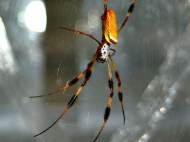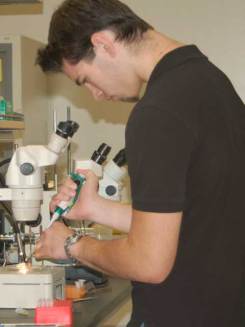Non-invasive way to study spider silk properties
 As you can see from our news and articles about bionspiration coming from spiders, spider silk keeps on intriguing researchers to analyze it and develop new materials. Researchers at the Arizona State University (ASU) have used a non-invasive way to obtain a wide variety of elastic properties of the silk of several intact spider webs by using a laser light scattering technique which was invented over 90 years ago.
As you can see from our news and articles about bionspiration coming from spiders, spider silk keeps on intriguing researchers to analyze it and develop new materials. Researchers at the Arizona State University (ASU) have used a non-invasive way to obtain a wide variety of elastic properties of the silk of several intact spider webs by using a laser light scattering technique which was invented over 90 years ago.
Weight for weight, spider web is at least five times as strong as piano wire. The fiber that spiders spin is a biological polymer is related to collagen (the most abundant protein in mammals) but far more complex in its structure. The ASU team of chemists is studying its molecular structure in an effort to produce materials ranging from bulletproof vests to artificial tendons.
“Spider silk has a unique combination of mechanical strength and elasticity that make it one of the toughest materials we know”, said Jeffery Yarger, a professor in ASU’s Department of Chemistry and Biochemistry and lead researcher of the study. “This work represents the most complete understanding we have of the underlying mechanical properties of spider silks.”
The researchers investigated 4 different types of spider webs spun by Nephila clavipes (pictured above), Argiope aurantia, Latrodectus hesperus, and Peucetia viridans. Each of these kinds were selected due to specific abilities of their webs such as the ability to absorb water in high humidity. This ability is especially exibited in silk spun by N. clavipes, since absorbed water shrinks an unrestrained fiber by up to 50 percent. A. aurantia may be recycling the chemicals used in web building, since it consumes the circular interior part of the web and then rebuilds it each morning with fresh new silk.
Investigating spider silk with Brillouin scattering technique
Their method relies on Brillouin scattering – a phenomenon occurring when light in a medium changes its energy (frequency) and path after interacting with time-dependent optical density variations. In order to use the Brillouin light scattering technique, the researchers used an extremely low power laser (less than 3.5 milliwatts). In comparison, average laser pointers have power of 5mW.
Recording what happened to this laser beam as it passed through the intact spider webs enabled the ASU researchers to spatially map the elastic stiffness of each web without deforming or disrupting it. Their results are consistent with the hypothesis that supercontraction helps the spider tailor the properties of the silk during spinning. This type of behavior, specifically adjusting mechanical properties by simply adjusting water content, is inspirational from a bio-inspired mechanical structure perspective.“This study is unique in that we can extract all the elastic properties of spider silk that cannot and have not been measured with conventional testing”, said Yarger. “This information should help provide a blueprint for structural engineering of an abundant array of bio-inspired materials, such as precise materials engineering of synthetic fibers to create stronger, stretchier and more elastic materials.”
For more information, read the article published in the Nature materials: “Non-invasive determination of the complete elastic moduli of spider silks“.










Leave your response!